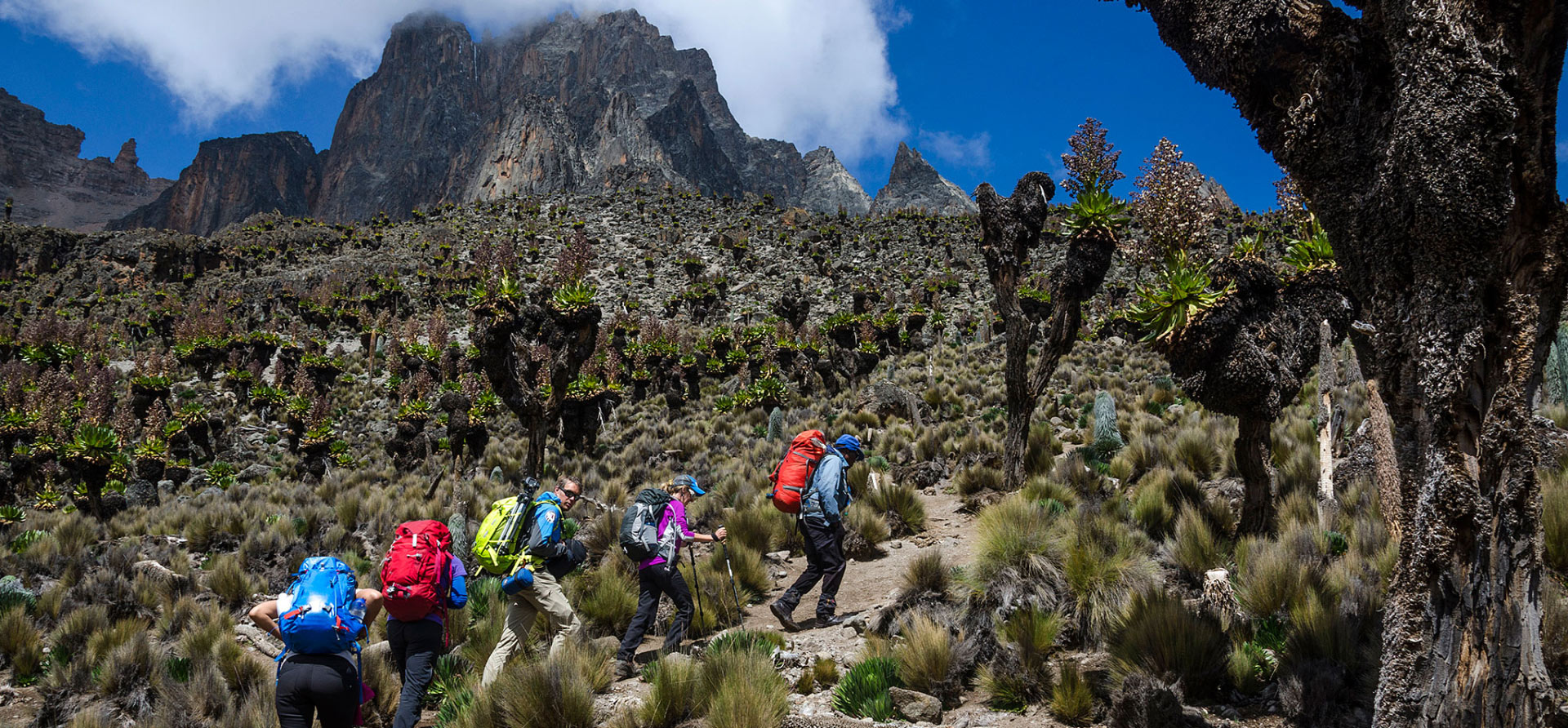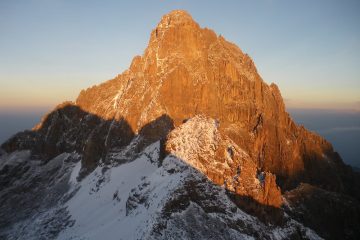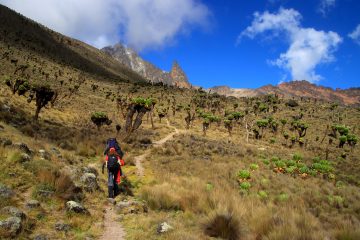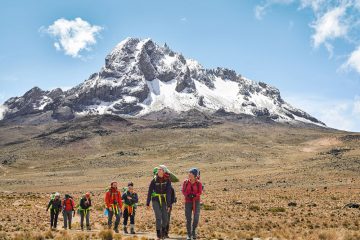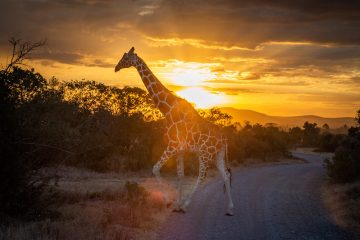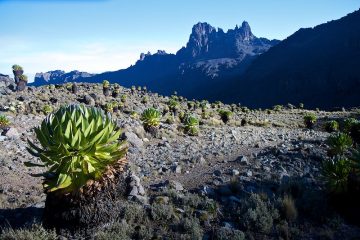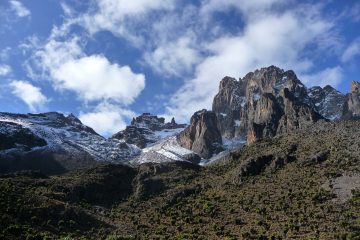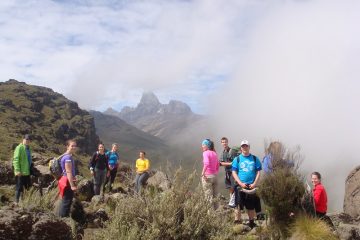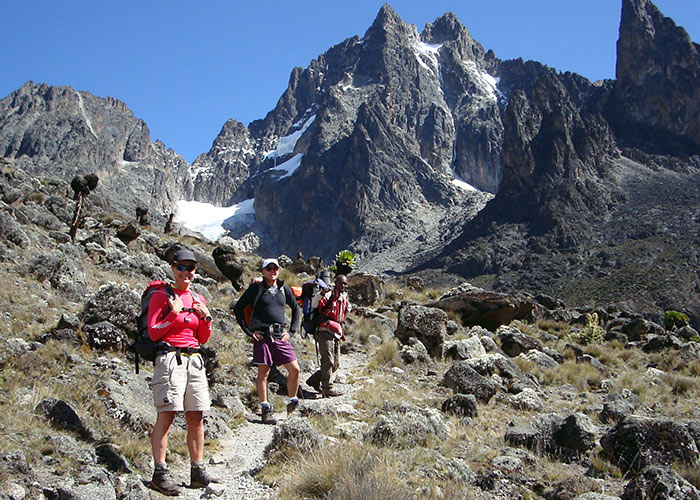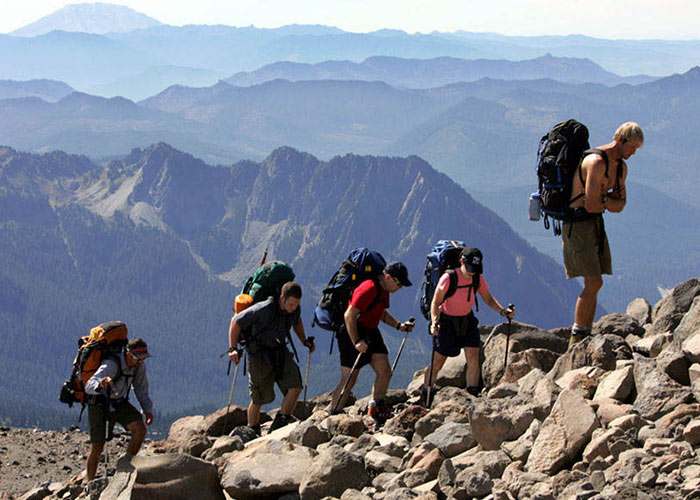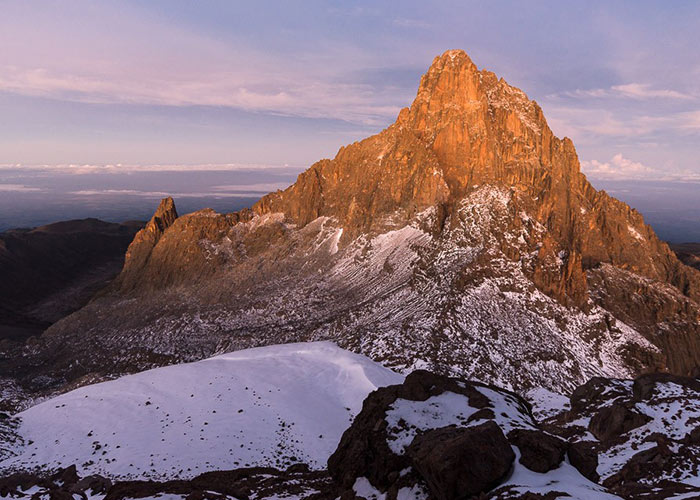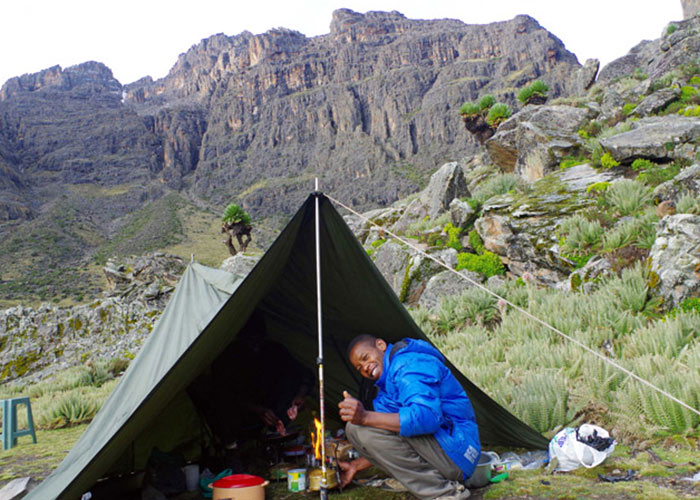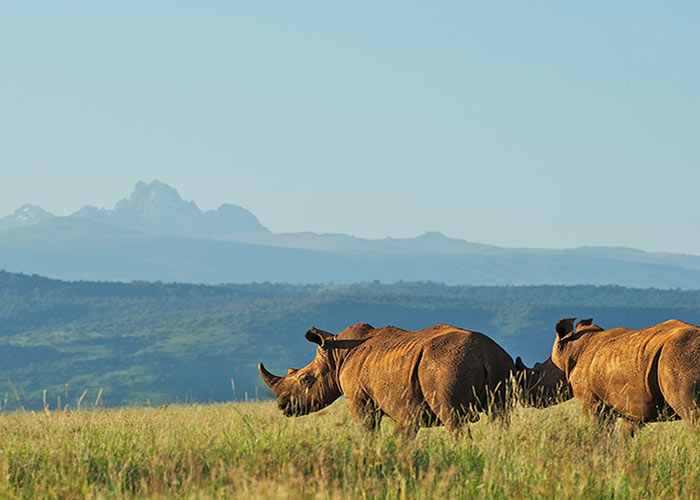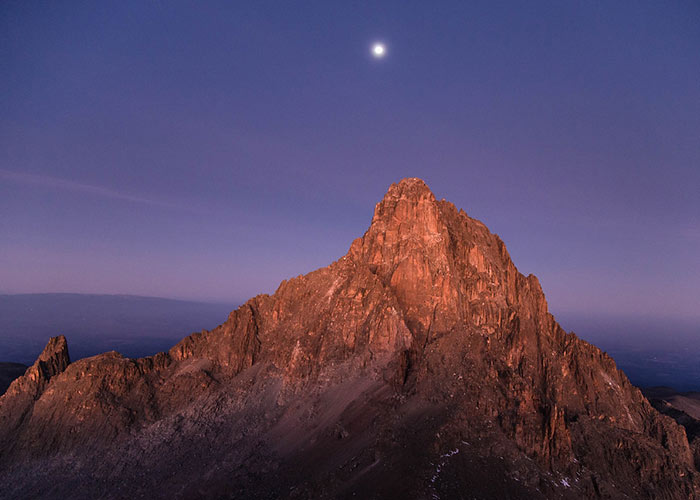Footwear – Good comfortable walking boots with a sole that will grip. Try wearing your boots in first and ensure they are comfortable. Sports shoes should only be used on the lower slopes, and their grip can be affected by mud. Taking a spare pair of light shoes or sandals for the huts is also a good idea.
Clothing – Although in the tropics, it is possible to experience both the hot sun and freezing temperatures, it is essential that you bring warm clothing. Mount Kenya is a unique mountain and it can experience snowfall at any time of year. However, it is possible to get sunburnt in the thin air. It is recommended that you wear light layers on the lower part of the mountain but bring a down jacket or fleece and a good quality waterproof jacket and trousers.
Fitness – Good general fitness is important for any trek. Regular, long walks in hill areas or hard physical training involving stamina-related activities such as running, swimming, and cycling are the best ways to improve your physical condition.
See our recommended gear list for your Mount Kenya group trek
Preparation is fundamental to the success of any trek. There are several key areas you should focus on to ensure you are fully prepared for a trek on Mt Kenya:
Sample 5 Days Mount Kenya Group Trek
We recommend joining one of the treks listed below as there are cost savings to be made by sharing transport and guide fees with other like-minded. The group chart is updated on a regular basis and should you be interested in any of these dates, please do not hesitate to contact us for further details. Imagine climbing Mt Kenya’s highest peak, Batian 5.199M, or Nelion 5.188M. How about a trip to the intriguing Lake Michaelson or visiting the spectacular Hall Tarn. With Tranquil Kilimanjaro, Mt Kenya’s premier mountain guide services, these goals are well within your reach. Tranquil Kilimanjaro has been leading mountaineering and trekking expeditions on Mt Kenya for over 10 years. Pathways lead through a variety of distinct moorlands – home to an amazing array of colourful alpine flowers. Unique and diverse range of wildlife in the Mt Kenya National Park – this includes… elephant, rhino, buffalo, and monkeys, plus numerous bird and insect species. High altitude game viewing can also be found here at Point Lenana and areas around the Austrian Hut. On the best weather days you can gain views of the main peaks whilst on the climb towards Pt Lenana. A Mt Kenya safari is also a great way to start or finish a trek/climb and the Sirimon and Chogoria routes offer a fine choice of treks from the gates.
You will be picked up from your hotel at 8.00am and driven to Nanyuki where we stop for lunch, taking about 4 hours. After lunch, we will be driven to Sirimon Park Gate, about 1 hour. At this point, you can buy all your fresh food for the trip from the many shops here before entering the park. We commence the hike from the park gate to Judmaier camp. The path takes us through the rainforest, which is truly amazing in its beauty and lushness, about 3 hours on foot. Arrive at the first camp, Judmaier, and it is clear of forest fires. It is not more lovely than any other camp at 1600 – 3500. On the first night, you would have to plan on cooking for yourself, or dinner can be provided at a small extra cost. This full day of hiking is an easy way to get acclimatized to the altitude. You will need to be prepared for very changeable weather, and rain gear is very important.
This day should be used to sharpen your skills of ascending and acclimatize. You will be able to see spectacular views of the main peaks. Head towards the western ridge of the Huts, and continue up to an area with a few Macedonian huts at 3993m. This is the site of Kami Huts, used for the communal ascent in July and the summit assault in December. To the left of the Huts is a good river which is a good place to fill up water supplies. If it’s a sunny day (and it should be!), it will be possible to wash and dry clothes on the rocks, a rare luxury. This point is known as first Kuffer’s Corner. Ensure an acclimatization walk continues up for a short time to reach the next prominence, Kuffer’s Corner. This beautiful area rightly deserves a full day of acclimatization to take in the spectacular views of Batian and Nelion also a good opportunity to recce the route up the Batian. Finally descend in good time to Kibowen Huts to go to bed early for the next day’s alpine start. These various routes can be mixed in response to the weather and how well individuals are feeling. Note the only other food preparation area is at Minto’s hut so if the group is spread between different huts only a packed lunch can be prepared. Step by step ascent on day 2 Follow a step by step ascent, to help acclimatization, the route should visit Point Lenana coming back down to sleep at higher altitudes. An extra day at 4790m can be taken if needed before the final push to the summit. This is the most beneficial way for success on the mountain an extra day at 4790m before the final push to the summit gives ultimate chances of success. Success can be achieved with less but our aim is to climb this mountain with a safe and sure approach. An extra day here should see those feeling the effects of altitude in the early stages back on form and ready for the summit assault. On summit day everyone should be sharing the same hut to try and make the most compact and final camp before the summit assault.
The approach to the summit is slow and steady, with only the distance covered and altitude gained being important. An early start ensures a leisurely pace and an arrival at the summit with plenty of time to take photographs and enjoy the spectacular views. The day starts at 6 am with a quick cup of tea or coffee and porridge as you prepare for the long trek up. You should carry as little as possible; at this altitude, every extra kilogram is felt. A water bottle, your camera, film, and a few sweets (or other snacks) for the walk up are about as much as you’ll need. You will notice that we do not make up food packets for your summit attempt; in the morning, you will need to prepare your own lunch packet. There are two reasons for this: firstly, many climbers are not feeling very hungry at this time of the morning and find it easier to nibble at leisure, and secondly, some decide not to go all the way to the summit, stopping their ascent at Gillman’s or Bation, and we then know that they still have a packed lunch for the return journey. Also, it is often far too cold to sit around at the summit to prepare lunch, and most people will eat during their descent.
In the morning of the fourth day, we will have a substantial breakfast before we begin our descent. This will take us down a different route to pick up vehicles for the transfer back to your hotel in time for a well-earned shower! This descent will offer a good opportunity to explore more of the fascinating vegetation on the mountain. Our driver will be waiting for you and will be more than happy to take you to a shop on the way back if you would like to buy a few beers. A great way to spend the last evening together, the crew will be singing and dancing as they have done every night on the mountain. Mixed in with the crew, the climbers are encouraged to join in and express their gratitude with a small “tip” and singing and dancing with the crew. It is a lively evening which none of us will forget!
A CORDIAL WELCOME TO MOUNT KENYA CLIMBING AND TREKKING. Trek to point Lenana (4985m) or Nelion peak (5188m) on Mount Kenya for the best acclimatisation prior to any Kenya and Tanzania expedition. Our social ethical and enviromental commitment based in Kenya offers the best possible conditions for your trek to High Altitude peaks.
If you should happen to have been successful in climbing to the third-highest peak in Africa, you certainly deserve congratulations! Understandably, some trekkers will spend their last morning taking in the sunrise from Pt. Lenana and then take up to six hours to descend directly to the park gate. However, I recommend you take the traverse route along the south side of the peaks, with great views of the surging Nithi River. This route also affords a last look at the fascinating tarns and a final lunch stop at what is, on the Day-mole route, the last night’s camp, near the road head. Rock hyrax watching at the Met Station. An extra half an hour of traversing back the way you came brings you to a small trail which drops to the right (looking down) into a shallow gully containing the Met Station, where you can divert for a cup of tea. This trail meets the main track for the last time, back at the Naromoru route road head, which is two hours from the Met Station. From here, it is a steady two-hour walk, through the bamboo forest, to the park gate, which can be reached by mid-afternoon. A vehicle will be waiting for you here to take you back to your lodge for a well-earned shower and a great tusker or two!
Safety is always a major concern for independent hikers, and we are often asked by Mount Kenya clients whether our experienced guides will ensure their well-being. Travellers on group joining treks will sleep in designated “Huts” along the route, and this substantially improves the safety of the trek. We have the highest standards of safety on the mountain. Our guides are Wilderness First Responder certified by the prestigious NOLS and carry first aid kits and pulse oximeters. The goal of the first oximeter reading is to get an idea of your normal blood oxygen levels so that in the event of illness on the mountain, guides can compare readings and make an informed decision regarding leaving altitude. With particular importance to clients who may be affected by Acute Mountain Sickness (AMS), be it from the altitude or perhaps a secondary illness i.e. chest infection, the aforementioned decision to descend an ill client will be significantly more informed and potentially save the unnecessary medical evacuation of a client. In the event of serious illness or injury, an emergency evacuation from Mount Kenya can be executed with the assistance of the Mount Kenya National Park rescue team. With vehicle or even helicopter evacuation possible from some areas of Mount Kenya, this rapid evacuation to definitive care may well be the decision which significantly improves the ultimate outcome. In more serious cases of illness or injury, a rescue from Mount Kenya by the park rescue team can be arranged. Clients who may require the service will be safely escorted by a guide to the nearest road access point to facilitate evacuation from the mountain. The length of a rescue will vary depending on the location of a client on Mount Kenya, typically taking no longer than 1 day to reach help. Although this is very rare, all clients of Team Kilimanjaro are, on the rare occasion of serious medical evacuation from trekking areas, assured of rapid and safe transfer to definitive care. An example of our service can be seen from a recent rescue we organized for a client from high on Kili who had dislocated his knee. This rescue was eventually executed with the assistance of the Kilimanjaro search and rescue team and with the use of a rescue stretcher, he was able to descend to safe care at a helicopter evacuation point at Horombo.
Quality of equipment is a key factor in ensuring a successful trek. It is not necessary to spend a lot of money, but the importance of having the right equipment cannot be overemphasized. The equatorial sun at high altitude can be intense, so it is important to use skin protection (hats, sunglasses, sunblock) and maintain hydration. The UV on the mountain is extremely high, so do not underestimate the sun. It is also important to be able to stay warm and dry during the various conditions expected on the mountain. We recommend a layered clothing approach with a moisture-wicking base layer, a warm and insulating layer, and a waterproof outer shell. For the final summit day and the descent, thermal insulated gloves, a balaclava, and a warm down jacket are essential. It is paramount that all clothing and equipment be checked for its suitability and that it be tested for comfort and functionality. The following is a list of equipment and clothing that we recommend for the successful completion of your Mount Kenya trek. It may seem extensive, but remember that the nights are cold, and clag can persist in the forest and moorland zones. Also, temperatures can drop dramatically in bad weather and in the event of an accident or illness, the essential clothing and equipment may help to save a life.
Tented treks equipment is uniquely designed to support both small and large groups, as the rain fly extends to create a porch area to store extra gear you bring or to simply sit and enjoy the view! Tents are pitched within the national park in designated camping areas. Our cook and all the kitchen equipment is brought to ensure that all meals are cooked fresh. Water boiled each day is always on hand for warm beverages. Your guide will assign a personal tent to be used for the duration of your trek. Privacy and security are considered in camp placement, and your tent and gear are neatly stored in your absence. We offer both single and double occupancy tents determined by your level of comfort. Pricing is based on shared accommodations in a double occupancy tent. Any long-term equipment or food stores are kept on-site in a staff tent or in a client-designated low-use area. After the sun goes down and the temperature drops, nights are best spent in the dining tent where the group can enjoy each other’s company as well as a freshly cooked dinner!
Depending on the route you choose, accommodation for your Mount Kenya Group Joining Trek will either be in mountain huts or tents. The park has a policy of having all clients and support staff in the group to share the mountain hut accommodations. The huts have thin mattresses; clients are therefore advised to bring their own sleeping bags. Public toilets and washrooms are available at all the hut sites.
Mount Kenya hosts a great variety of wildlife and breathtaking natural sceneries. Some of the wildlife that may be spotted on routes up the mountain include: Black and White Colobus and Sykes monkeys, buffalo, elephant, bushbuck, and eland. The vegetation is equally diverse. The main zones of cultivation give way to forest, bamboo, high altitude heath, and a rock and ice-covered summit. A trek on Mount Kenya passes through all these vegetation zones, and the variety of flora and fauna can be experienced in a short period of time. You walk from the equator into a kind of Arctic environment in only 5 days. This makes the experience on Mount Kenya quite unique. The forest is abundant with wildlife, including a variety of antelope, elephant, and buffalo. The high altitude areas contain several unique species of plants and animals, and it is common to see buffalo and elephant grazing in the meadows. The higher bamboo zone is said to contain the highest density of leopard in Africa, though seeing these nocturnal animals can be rare. Other wildlife found in the bamboo zone includes: giant forest hog, tree hyrax, cape buffalo, and several types of monkey. The high altitude heath is mainly grazing land and home to the eland. The 4-horned eland is the largest of all the antelope and is quite common in the Mount Kenya region. Come and join a Mount Kenya group joining trek and see what wildlife and nature awaits you!
Follow the guide’s advice and adhere to the itinerary stage by stage. To avoid altitude sickness, it is important to take the climb slowly, acclimatizing as you go. Drinking plenty of fluids and a walking pace that is comfortable for you are important factors. We have a medical oxygen cylinder on standby at all times, and guide staff are trained to use this. All guides are also trained to monitor and deal with the effects of altitude on our clients. While knowing the symptoms of altitude sickness is important, it is worth noting that most people experience no more than a mild headache, which will disappear after a good night’s sleep and descending to a lower altitude. Do keep an eye on any of your fellow climbers and alert our staff if you think there is a problem. – Mountain weather is unpredictable, and weather conditions can change rapidly, so be prepared for all seasons. Dry thermal days can suddenly change to misty, rainy, or snowy conditions. Wind can make the air feel very cold. As a general guide, daytime temperatures can range from 25°C to 30°C at 2500m and 18°C to 23°C at 3750m. Night-time temperatures can range from 14°C to -10°C over the same altitudes. At 4750m, daytime temperatures will range from 16°C to 5°C and can be as low as -5°C at dawn. Night-time temperatures will range from 8°C to -6°C. Always carry waterproofs! A mist can quickly change to rain or snow, which can make the ground very slippery, so we also suggest gaiters and walking poles to help on muddy or snowy terrain. Come prepared. If you have no experience of cold climates, then ask us, and we can offer information and advice.
Can I hire/purchase some of the gear I don’t have? –
Each client should get all of the essential gear before they arrive, e.g. sleeping bags, waterproof jackets & trousers. However, there are a few items that can be hired locally from equipment stores in Nairobi, such as gaiters, walking poles. If any of the equipment gets damaged on the mountain, we will exchange or replace it free of charge.
What is the currency and how do I pay?
We only accept cash payment in US dollars. Large denominations attract a better exchange rate (e.g. $100s & $50s). It is essential to bring notes that are unmarked and not older than the year 2006. *We have had reports of money being confiscated as it is considered counterfeit due to pen marks and general condition*. ENSURE that your bank notes have NO rips or tears. This is due to many places REJECTING notes that are slightly damaged. Make sure that you are given good quality notes when you exchange your money as banks in Kenya often give out old/damaged notes.
What’s the average size of the group?
On the mountain, the average group size is 2-6 clients with a maximum of 12. If you would like a private trek, just let us know, and we will arrange it for you.
Related: Kilimanjaro Group Tour Dates

